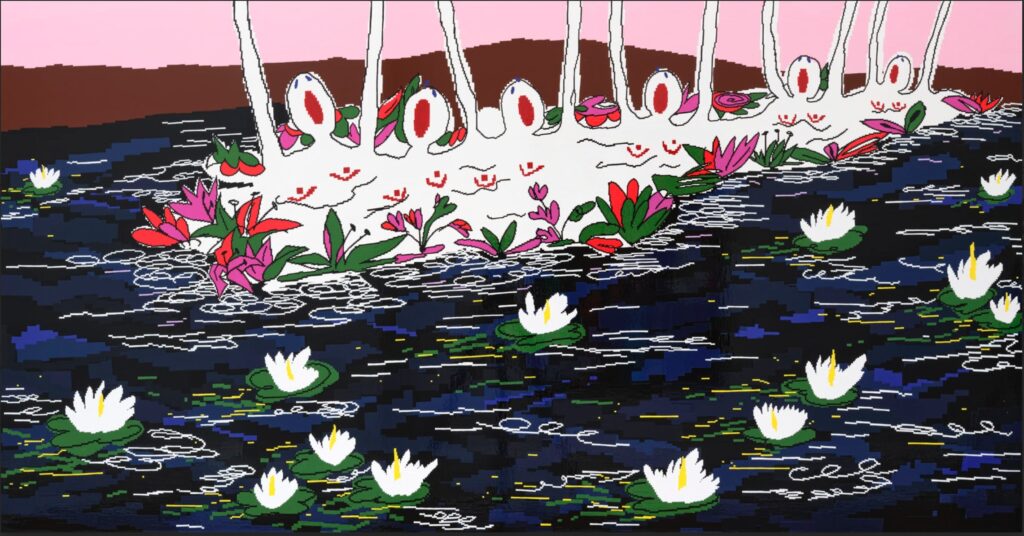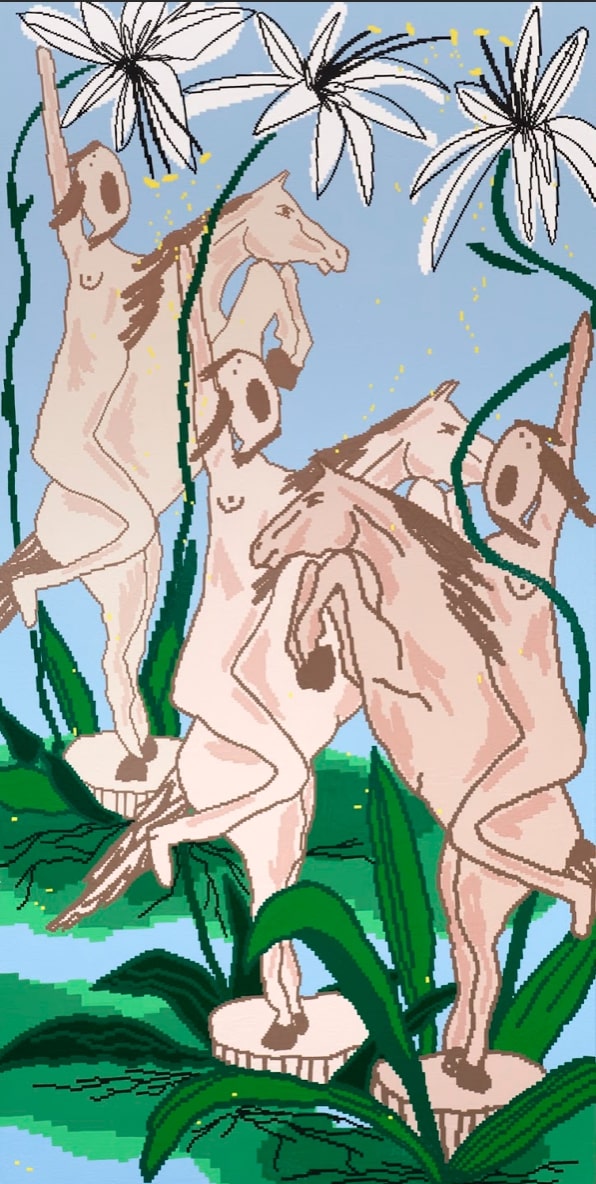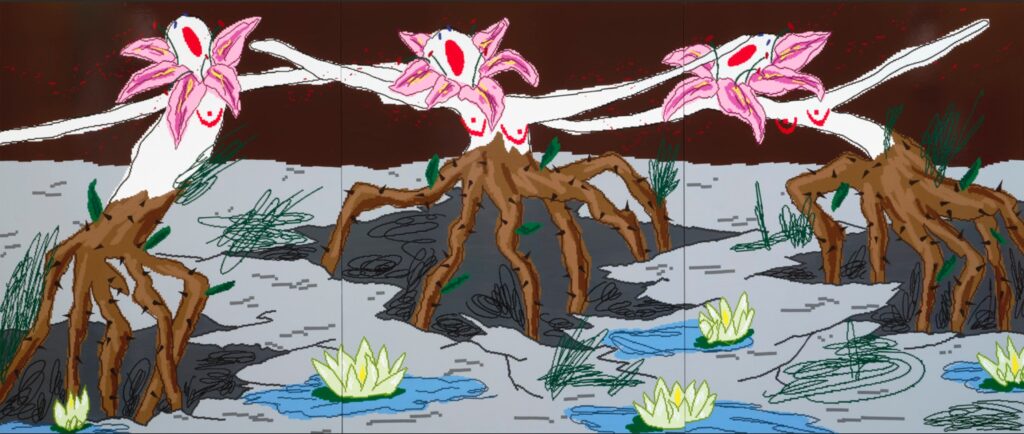Share this
The opening of Belgrade-born artist Maja Djordjevic’s exhibition ‘HOPE AND REBIRTH’ at Carl Kostyál was righteous. Oli Epp, one of the gallery’s roster artists, roamed about the crowded space with a life-sized inflatable balloon woman inspired by the now iconic nude female figure in Djordjevic’s paintings. Even stranger – David Crofts, the creator of said inflatable sculpture, drove the blow-up girl to the post-private view dinner where she was nearly stolen by a VIP guest. Perhaps balloons and hot young artists have more in common than appearances first suggest – everybody wants them but very few can have them.
Opening night antics aside, the confident new body of work on show at Carl Kostyál in London sees Djordjevic taking on a much more serious tone than aforementioned events may suggest. Made up of six commanding paintings, the exhibition was created as a response to the tumultuousness of the past few years. Each lyrical and delicately rendered piece speaks of Djordjevic’s immense sadness at the state of the world today, seeing the artist exploring stories of trauma and crisis, alongside hopeful narratives of peace, restoration, equality and tranquillity. Utilising flowers as symbolic devices to convey the otherwise ineffable spectrum of human emotion, and allowing her figures to become unspecific stand-ins for all humankind, this captivating exhibition marks a moment of considerable development for the artist while transposing a salient message for troubled times.
Currently based in London, this show cements Maja Djordjevic as one to watch. In recent years, she has also presented solo exhibitions with Dio Horia Gallery in Athens, Balkan Projects in Los Angeles and The Hole in New York, alongside turning heads at art fairs including Taipei Dangdai and Art021. Her work has also appeared in group shows at Arsenal Contemporary in New York; the Ludwig Museum in Budapest; the MODEM Modern and Contemporary Arts Centre in Hungary and Plus-One Gallery in Antwerpen among others, while her pieces are held in the prestigious permanent collections such as the X Museum and the Mwoods Museum in Beijing.
To find out more about the process behind her new body of work, we caught up with Maja Djordjevic just after her exhibition opened in London.

First off, your work has such a distinct style – it feels digital but also a little retro. Can you tell me about how you arrived at this aesthetic and describe your process?
My current practice can be traced back to my childhood. I’m a 90s baby – I grew up with Sega, Nintendo, arcade games, and of course Microsoft Paint. When I was little, I used to host drawing competitions on Paint – my friends would all gather around and try to draw the best fairy, wizard or dinosaur. Being young and mischievous, we also used to make little drawings of naked people – perhaps an early exploration of our sexuality, or maybe just a way to be a bit naughty. I think we loved Paint so much because we could easily erase our pictures, keeping them away from the prying eyes of our parents.
Many years later, while I was at the University of Arts in Belgrade receiving a very traditional education, I found myself returning to Paint as a way to keep a more spontaneous and instinctive visual diary. Out of nowhere, the naked girl I had drawn as a child reappeared as the protagonist. I became more and more interested in the images I was rendering on paint, compared to my studio practice at the time. This inspired me to attempt to transfer these digital scenes onto the canvas. It’s a real challenge to paint a small screen image on a large-scale canvas by hand, but I’ve become quite good at it over time. Without using stencils, projections or tape, I paint these scenes pixel by pixel with a super shiny oil-based enamel paint. In this way, my work retains something of the digital from which it was born – a unique surface texture that mirrors the experience of looking at a screen. As a result, mine are definitely the kind of pieces that are best seen in person!

This recent series, on show at Carl Kostyál in London, appears very confident and bold. Often you have sculptural elements in your shows, but in this instance the pieces stand alone in a traditional hang. Can you tell me more about how you chose to display the work and why?
Thank you, I’m really glad it gives that impression! When I exhibit my work, I really like to think carefully about the arrangement and the space – it’s so important to how the work is received. I often bring my paintings off the wall, putting them together in unusual ways to underscore their meanings.
For my solo during the pandemic at Carl Kostyál titled ‘This must be the place’, I was thinking about the home as a space that had become so central to people’s lives under lockdown. For a time, homes were like the stages on which we acted out our entire existence. As such, I combined my paintings into furniture like assemblages – a chair or a table – to inject some humour and absurdity into the situation we had all found ourselves in. The exhibition space really helped carry this message, with the wood-panelled walls and visible fireplace making it seem like a weird and oddly inviting living-room.
For my current exhibition, ‘HOPE AND REBIRTH’, I felt like I really wanted the works to just speak for themselves. The message contained within them is very personal and speaks to a desire for peace and equality during times of conflict.

This leads me on to wanting to understand more about your new series, tell me more about the ideas behind it?
I feel like wherever I look there is suffering. On a global scale, we are currently faced with multiple wars, scenes of immense violence and the ever-looming threat of ecological devastation. I don’t know about you, but there isn’t a day that goes by when I don’t feel the weight of this. Just opening my phone and seeing the news or posts on social media reduces me to tears. For a while, I have felt like I am powerless in the face of it all; I cry and mourn but there is little I can personally do to end all of this suffering. The series is a response to this feeling – sadness, helplessness, empathy and a desire to take action without clarity on what action to take.
The nude female figure has been central to my work for over ten years, always deployed as a way to explore themes of vulnerability. Previously this was perhaps more personal or humorous, but in this case, she speaks to something deeper. She is a conduit through which to explore collective traumas, both past and present, and a vehicle to invite hope through empathy. The figure does not represent one particular narrative or individual, instead she is a universal symbol for all of humanity – in this way, she invites viewers to identify with her as a figure of unity, peace, hope and, as the title suggests, rebirth.

What was the process like putting this show together? How long have you been working on it and how did you feel about it?
To put it briefly – difficult, long, and necessary!
One particular work stands out to me when answering this question – ‘I’m afraid there’s no one to save me’. Inspired by Delacroix’s iconic history painting, ‘Liberty Leading the People’, my figure is seen waving a peace lily as if it were a white flag. I think this particular work really captures the message I want the show to carry – one of freedom. By referring back to a people’s uprising as depicted by Delacroix – the July Revolution of 1830 – I think this work becomes an invitation for the viewer to contemplate the forces to which they are subjected, and be reminded that they can break free.

Many of the pieces contain Lilies, and draw heavily on the different symbolism associated with certain species of the flower. How did you discover this and why does it feel important to these works?
The emotions I was experiencing felt ineffable. Initially, I wasn’t really sure how to put them into paintings. Then I remembered the story of Eve’s expulsion from the Garden of Eden – Lilies of the Valley are said to have grown from the tears she cried as she left this realm of eternal peace. I realised that flowers, especially lilies, are so rich with symbolism – they became my tools to express my complicated feelings.
My favourite painting for the series, ‘Memorial Roots’, in which seven girls transform into Lilies of the Valley, is based on the story of Eve. It is intended to speak to women’s suffering through the ages, while also acting as a bold reminder of their agency. The figures in this work refuse to cry silently or leave quietly, as Eve did, and instead find their voice – their gaping mouths serving as reminders that they will not be ignored.

The figure in your work, the girl, has become iconic. Oli Epp even had a life-sized balloon version made for the opening. What does she mean to you and how has her meaning changed over the years?
I am infinitely grateful to her. Through her I have been able to manifest all of my struggles, and the more universal struggles we all face, over the past ten years. She inspires me and allows me to truly express myself.
Of course, she has changed over time. I think I have hopefully improved a lot since I first painted her ten years ago! She had lost a sense of individual identity in some ways, and become more of a symbol. I’m quite happy about this as it allows me to speak on themes that transcend just my own experience.
I am so grateful to have a friend like Oli Epp too, he is always so supportive. Because of him, the girl in my paintings got to be at the opening too! Throughout this interview, the balloon girl has been sitting across from me and giving me support.


Do you consider your work to be inherently feminist? You focus very much on triumphant and vulnerable narratives surrounding women, what is this inspired by?
Absolutely. I want to speak about ALL WOMEN, and the many problems they have faced throughout time and in different places.
How was the exhibition title, ‘HOPE AND REBIRTH’ chosen and how are these ideas manifested in the paintings?
It took me a really long time to decide on the title for the show. I wrote a sentence in Serbian in my journal last year: “Za sve one preplakane bitke, gde nisam mogla nista da uradim”, roughly translated it means, “For all the battles I cry, but I couldn’t do nothing”. I wanted this to be the title, but I just couldn’t find the right words in English.
When I was looking back over my notes, as the show got closer and closer, I found a list I had made of the meanings for lilies. It was a very long list, and on two different pages in large letters I had written “HOPE” and “REBIRTH”. I don’t know why, but when I saw this, I immediately thought of the city of Chernobyl, and the way in which nature has overtaken urban architecture. It felt like a symbol of growth and change in the wake of devastation. This brought me back to the lilies, and how they feature in so many of my recent works to convey positive messages in a time of crisis and conflict. In the end, it felt like the simple power of these words was enough.
What do you hope viewers take from the show?
I hope that these works will encourage deeper reflection on our collective responsibility towards each other and the world in general. As Gerard Richter said, “Art is the highest form of hope. Those who take an interest in it find solace in art”. Art is here to address socio-political issues, it has long since been used as a form of response to crisis – the show exists within this legacy, the many incidences when individuals have made artworks in times of war or violence.
I genuinely feel devastated by the war, genocide, inequality, prejudice and environmental decline that I witness personally or on the news and in social media. I felt like I had to try and say something, to try and manifest otherwise inexpressible concepts such as peace and hope. As in my piece WE SYMPATHISE! WE DO!”, I honestly just want this show to feel like a call to lay down our weapons and to join hands instead. I know I can’t fix anything with art alone, but maybe people need to be reminded of their humanity, and to think harder about what they can contribute to the development of a better world.
